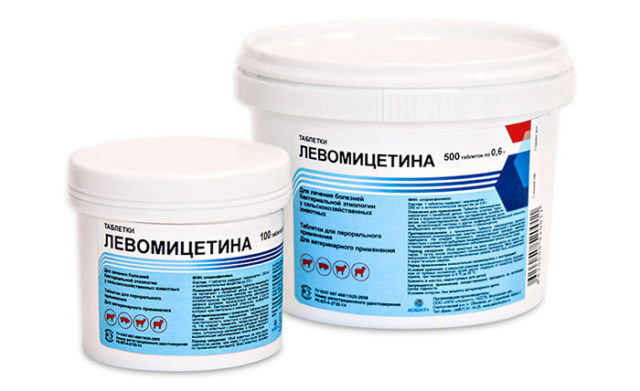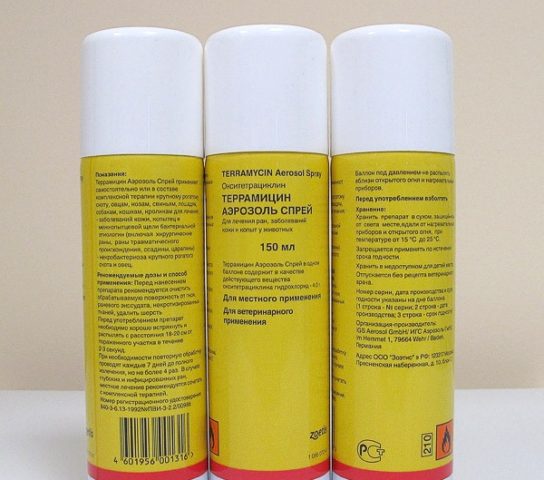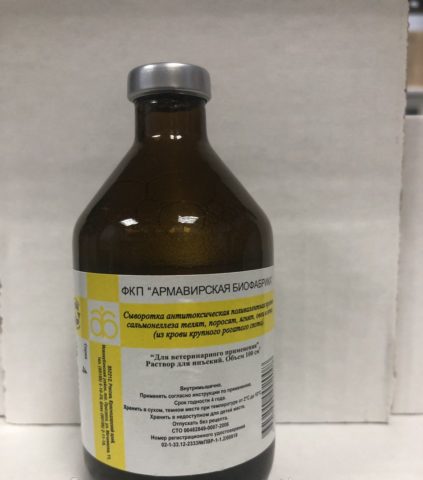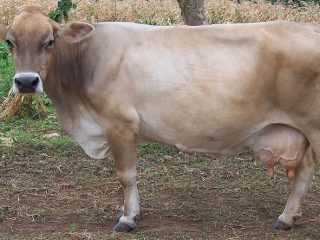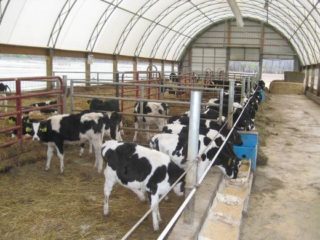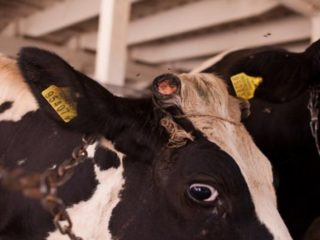Content
Salmonellosis in calves is a widespread disease that sooner or later almost all farms face. Basically, the disease affects just young animals up to two months old, since in adults, resistance to various infections is higher. The danger of salmonellosis lies in the fact that it can be transmitted not only to other animals, but also to humans.
What is salmonellosis
Salmonellosis is an infectious disease that can affect many species of animals and birds. The disease is caused by Salmonella bacteria - microorganisms resistant to adverse environmental conditions, so even equipment for working with animals can cause a repeated outbreak of infection. Also, the premises where the sick calves were located can remain infected for a long time.
The peak period of the disease occurs in the spring - the time of mass calving, but in general, salmonellosis can develop in cattle at any time of the year. Small calves, especially newborns, are very vulnerable to this disease. They may have symptoms of salmonellosis as early as the 10th day after birth. The higher the unsanitary conditions for keeping cattle, the greater the likelihood of an outbreak of salmonellosis in the herd.
Pathogenesis of salmonellosis
Carriers of salmonellosis are rodents and adult cows, in which the disease is most often asymptomatic. The infection is usually transmitted to young calves through milk or contaminated equipment, however, the conditions of the barn play an equally important role. If the room is rarely cleaned, the likelihood of developing salmonellosis increases, as it can be transmitted through urine and feces of cattle. First of all, the infection affects individuals with weakened immunity - calves that have recently been ill with something, or animals that are deficient in vitamins. In the latter case, the cows receive poor quality or extremely monotonous feed.
Salmonellosis symptoms may appear the day after infection or two weeks later. The disease proceeds in a mild, acute and chronic form, however, their symptoms are very similar.
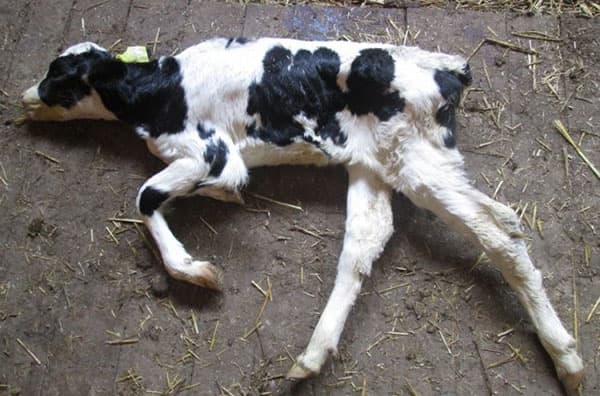
Salmonellosis causes weakness and apathy in affected animals
Symptoms of salmonellosis in calves
Changes in animal behavior and physiology may indicate that the calves are affected by salmonellosis:
- They become lethargic and lethargic, sleeping or just lying down most of the time.
- Mucus of a transparent color is abundantly secreted from the nose.
- Animals stop eating or eat very little.
- Sometimes, 2-3 days after infection in sick calves, a change in stool is noted - it becomes liquid and frequent, and diarrhea begins. The stool contains gray mucus and blood.
- The acute course of salmonellosis is characterized by a high temperature - it can increase to 40-42 ° C.
- If the disease is severe, the calves experience increased urination. The process becomes painful, blood is present in the urine.
- In the acute form of salmonellosis in sick animals, cough, runny nose and conjunctivitis are additionally noted. If the infection is delayed, the calves may develop a fever.
The chronic form of salmonellosis develops if the disease is not detected on time or is simply taken too late for treatment. It is characterized by the same symptoms, but additionally arthritis and respiratory diseases develop. Diarrhea disappears over time, appetite returns to sick individuals for a short time, however, weight loss is noted.
In time, the chronic form can stretch up to two months.
Diagnosis of salmonellosis
The diagnosis of salmonellosis in calves is complicated by the fact that the characteristic signs of infection are similar to the symptoms of other diseases:
- colibacillosis (the age of the young is less than 10 days, there is sepsis and serous inflammation of the lymph nodes);
- pasteurellosis (lobar pneumonia is present);
- dyspepsia (calves are less than 10 days old, sepsis is not observed);
- streptococcal infection (diagnosed with pericarditis, pleurisy).
The diagnosis is made after a comprehensive examination of the calves. To do this, it is necessary to send blood and feces taken from sick animals to the laboratory.
Treatment of salmonellosis in cattle
The first thing to do after detecting salmonellosis in calves is to separate the sick individual from the rest of the herd to prevent the spread of the disease. After that, they begin complex treatment using antibiotics and auxiliary drugs. Most often, a veterinarian for salmonellosis prescribes the following drugs:
- Levomycetin veterinary in tablets for oral administration. The exact dosage is calculated by the veterinarian based on the weight of the calf. The recommended course of the drug is 3-4 days with a frequency of use three times a day.
"Levomycetin" is presented in different forms of release, however, for the treatment of cattle, the veterinary version in tablets is used
- "Terramycin". The course of treatment lasts about 5-6 days, for each kilogram of the animal's weight there is 0.02 g of the drug. The frequency of use is 2-3 times a day.
"Terramycin" is produced in the form of an aerosol and solution
- Polyvalent antitoxic serum. The action of the drug is aimed at strengthening immunity and preventing disease in calves and adult cows. Serum is injected intramuscularly, the dose is calculated by the doctor. It is recommended to divide the daily rate into several injections, between which they usually take a break of 3-5 hours.
All injections are carried out using disposable syringes, which are prohibited from reuse
For the treatment of salmonellosis in calves, do not use products that have expired. They can harm the health of animals.
Vaccine against salmonellosis in calves
The vaccine against salmonellosis is the most effective measure of protection against this disease. It is recommended to vaccinate calves 1-2 days after birth. The vaccine will not help already infected individuals, but a general strengthening of immunity is noted in healthy animals.
The drug begins to act on average on the 14th day. 10 days after the first vaccination, the second is usually given. For adult cows, the vaccine is given a month and a half before calving. In this case, a newborn calf is vaccinated only once and a little later - 15-20 days after birth.
If the veterinarian diagnoses any malaise in the young, the vaccination should be delayed a little.
Pathological changes in salmonellosis in calves
The acute course of the disease can affect the organs of the gastrointestinal tract, as a result of which the calves are diagnosed with gastroenteritis and sepsis. In chronic salmonellosis in sick individuals, the respiratory tract, digestive organs and the immune system are affected. Acute catarrhal inflammation begins in the rectum and small intestine of affected calves.
At two months of age, animals may develop exudative inflammation. The calves' liver enlarges, necrosis and salmonella nodules are formed in it.
Preventive actions
Salmonellosis can quickly spread to most of the herd if treatment is not started on time. However, it is even better not to allow an outbreak of the disease at all - for this it is enough to follow the most basic rules for keeping cattle:
- The barn should be cleaned at least once a week. At the same time, it is not enough just to remove dirt - it is also advisable to use various disinfectants. After each bowel movement, the floor in the room containing an adult animal or calf should be washed.
- In no case should you keep cattle in cramped conditions. If animals crowd close together in a small room, salmonellosis spreads very quickly. In addition, with such a content, it is necessary to clean the barn much more often.
- A quick inspection of the entire herd is recommended every day. This increases the chances of noticing the first symptoms of salmonellosis in time and starting timely treatment before the disease spreads to other animals.
- It is very important to regularly take cows and calves for walks. Good ventilation must be installed in the barn itself.
- To prevent rodents from entering the room, which are also carriers of infection, after each feeding, food debris is removed. It is not allowed to store food in bags in the same room.
- Drinking water for calves should be at room temperature. It is changed regularly - dirty drinking bowls often become sources of infection.
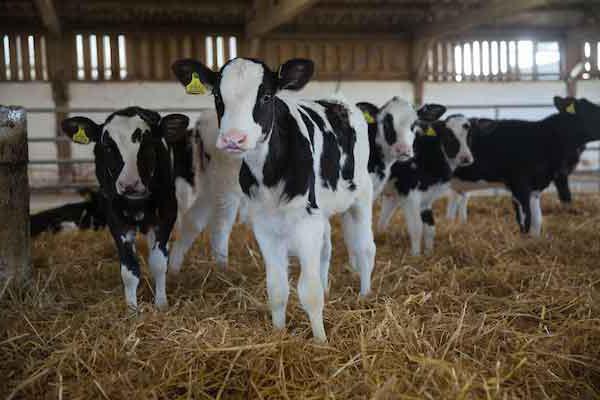
The risk of disease is lower if cattle are kept in a sufficiently spacious room
It is recommended to vaccinate pregnant cows on farms with salmonellosis problems. To do this, they are injected twice with a break of two months with a formal-leavened vaccine against paratyphoid fever of calves.
Good nutrition is also of great importance for the health of cattle. The lack of certain substances in the body of animals weakens their immunity, as a result of which they are unable to resist disease. In the summertime, calves should receive a sufficient amount of fresh feed; they should not be fed with rotten and rotten hay. With the onset of frost, the herd is released for walking carefully, since the grass already has time to freeze. Calves need to be supplemented with vitamins from time to time.
Conclusion
Salmonellosis in calves is a rather dangerous infectious disease, but with timely treatment, animals recover quickly. After an outbreak of infection, it is necessary to thoroughly disinfect all equipment that was used to work with calves, and the room where the sick individuals were. In the process of treatment, it is also important to consider your own safety - salmonellosis can be transmitted to humans.
More information about the symptoms, course of the disease and its treatment can be found in the video below:
